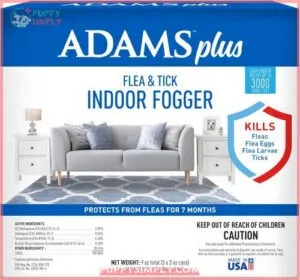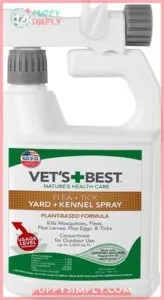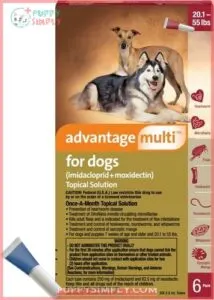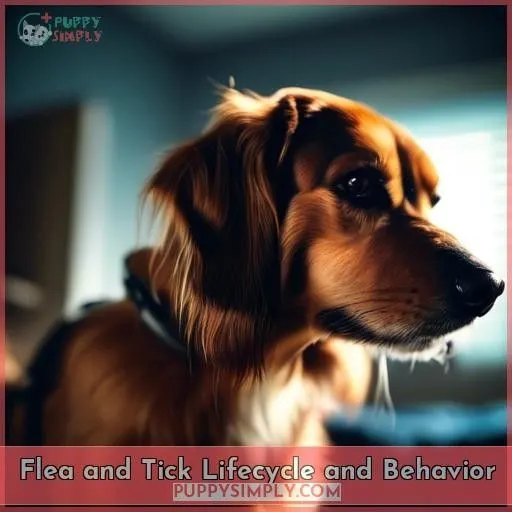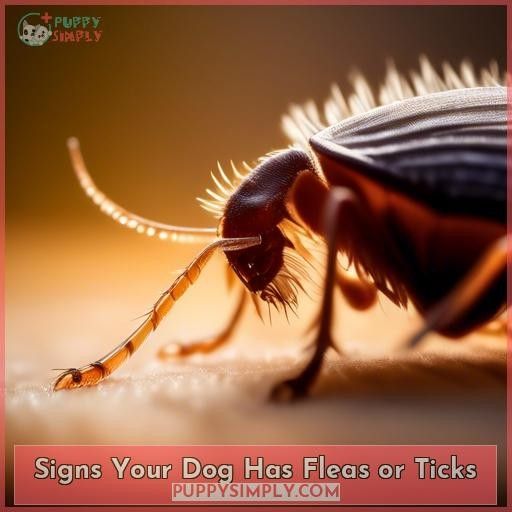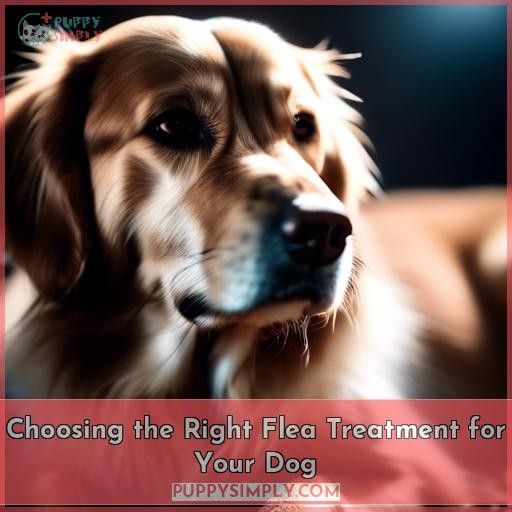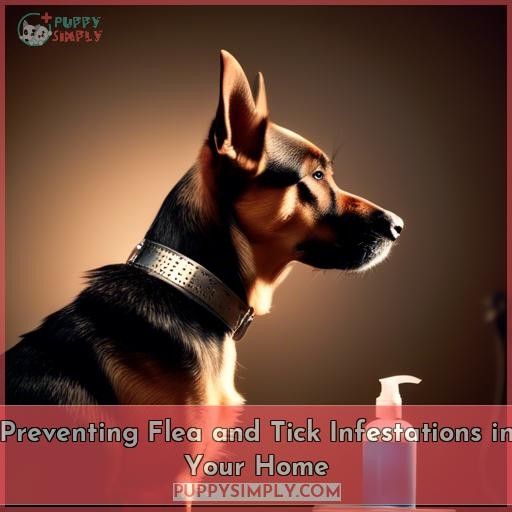This site is supported by our readers. We may earn a commission, at no cost to you, if you purchase through links.
 When picking the most suitable flea treatment for dogs, you’ll want to take into account your pup’s age, weight, and general health.
When picking the most suitable flea treatment for dogs, you’ll want to take into account your pup’s age, weight, and general health.
Topical solutions like Advantage Multi or Frontline Plus offer effective, long-lasting protection against fleas and ticks.
Oral medications such as Simparica Trio chewables fight multiple parasites with convenience.
To quickly eliminate existing infestations, try area sprays or foggers designed for home use.
Find out which top-rated options align perfectly with your pet’s needs.
Table Of Contents
- Key Takeaways
- 10 Best Flea Treatments for Dogs
- 1. Simparica Trio Chewable Tablets For Large Dogs
- 2. Virbac Knockout ES Area Treatment Spray
- 3. Pet Armor Home Carpet Spray Fresh Scent
- 4. Wondercide Lemongrass Flea Tick Home Pet Spray
- 5. Adams Plus Indoor Flea Fogger
- 6. Harris Nite Light Flea Insect Trap
- 7. Natural Care Flea Tick Carpet Powder
- 8. Vet’s Best Flea Tick Yard Kennel Spray
- 9. Advantage Multi Topical Solution for Dogs
- 10. Frontline Plus Flea Tick Spot Treatment Medium Dogs
- Flea and Tick Lifecycle and Behavior
- Signs Your Dog Has Fleas or Ticks
- Choosing the Right Flea Treatment for Your Dog
- Preventing Flea and Tick Infestations in Your Home
- Frequently Asked Questions (FAQs)
- Conclusion
Key Takeaways
- Topical solutions like Advantage Multi and Frontline Plus offer effective, long-lasting protection against fleas and ticks.
- Oral medications such as Simparica Trio chewables fight multiple parasites conveniently.
- Area sprays or foggers designed for home use can quickly eliminate existing infestations.
- When selecting the appropriate flea treatment for your canine companion, consider factors such as their age, weight, health status, and the extent of the infestation.
10 Best Flea Treatments for Dogs
Are you searching for the most effective flea treatments to ensure your canine companion remains pest-free? Consider our top 10 selections, encompassing chewable tablets, topical solutions, sprays, and more. From reputable brands such as Simparica, Advantage, and Frontline, these products provide thorough protection against fleas, ticks, and other parasites.
1. Simparica Trio Chewable Tablets For Large Dogs
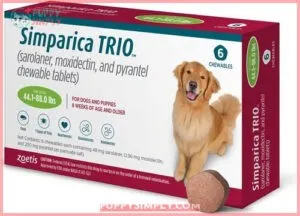
Simparica Trio Chewable Tablets For Large Dogs is a monthly preventative medication that safeguards your dog from heartworm disease, ticks, and fleas, as well as roundworms and hookworms. This chewable tablet is appropriate for dogs 8 weeks and older, weighing 44.1-88 lbs. It’s formulated with three proven ingredients: sarolaner, moxidectin, and pyrantel, which work in tandem to provide all-encompassing protection against diverse parasites.
Key Features:
- Kills adult fleas within 4 hours and ticks within 8 hours of ingestion, guaranteeing prompt relief for your pet.
- Provides an entire month of protection against fleas and ticks, maintaining your pet’s safety year-round.
- Available in six weight categories, making it suitable for dogs of all sizes.
- Can be administered directly to your dog or blended with food for an effortless experience.
Usage and Dosage:
Simparica Trio Chewable Tablets For Large Dogs should be administered orally once a month, at the recommended dosage based on your dog’s weight. It can be given with or without food, but care should be taken to guarantee that your dog consumes the entire dose.
Safety and Side Effects:
While Simparica Trio is generally safe for dogs, it may cause neurologic signs such as tremors, ataxia, and seizures in dogs with or without a history of neurologic disorders. Common side effects observed in clinical trials include vomiting and diarrhea. It’s crucial to consult with your veterinarian before initiating any new treatment for your pet.
Conclusion:
Simparica Trio Chewable Tablets For Large Dogs is a highly effective and convenient solution for preventing heartworm disease, ticks, and fleas in dogs. Its fast-acting formula and long-lasting protection make it a top choice for pet owners seeking comprehensive parasite control for their pets.
Best For: Dogs 8 weeks and older weighing 44.1-88 lbs.
- Prevents heartworm disease, kills fleas, and kills 5 types of ticks
- Treats and prevents flea infestations and controls roundworms and hookworms
- Convenient all-in-one tablet that dogs enjoy the taste of
- Requires a prescription from a vet
- Can cause neurologic signs in some dogs
- May be more expensive than other flea and tick treatments
2. Virbac Knockout ES Area Treatment Spray
Virbac Knockout ES Area Treatment Spray is a long-lasting solution for flea and tick infestations in your home. This product contains a combination of ingredients that kills both adult and pre-adult fleas, preventing their development into the adult biting stage. With its active ingredient, pyriproxyfen, it continues to kill fleas for 120 days (4 months). The spray reaches fleas hidden in carpets, rugs, drapes, upholstery, pet bedding, and floor cracks, providing continuous protection against reinfestation.
To use Virbac Knockout ES Area Treatment Spray, hold the can 2 or 3 feet from the surfaces to be treated and apply a sweeping motion to carpets, rugs, drapes, and all surfaces of upholstered furniture. Be sure to treat pet bedding, as it’s a primary hiding place for fleas, and there’s no need to remove pet bedding after treatment. Don’t treat pets with this product, and use a registered flea control product on your pets in conjunction with this treatment.
This spray leaves no objectionable odor or sticky mess and, used as directed, doesn’t stain furnishings. It’s important to follow the product label instructions carefully, as it’s a violation of federal law to use this product in a manner inconsistent with its labeling.
Best For: Homes with flea and tick infestations
- Kills adult and pre-adult fleas
- Prevents flea infestations for up to 4 months
- Reaches fleas hidden in various areas
- Not for use on pets
- Can be harmful if ingested
- Should not be used in areas where food is stored or prepared
3. Pet Armor Home Carpet Spray Fresh Scent
PetArmor Home Carpet Spray Fresh Scent is a topical flea and tick treatment designed for indoor use. It’s formulated to kill adult fleas, flea larvae, flea eggs, ticks, bed bugs, lice, and dust mites, providing long-lasting protection for up to 7 months. The product is effective in treating various surfaces, including carpets, rugs, upholstered furniture, draperies, and pet bedding. It’s recommended to apply the product in infested areas, such as pet beds, resting quarters, nearby cracks and crevices, along and behind baseboards, window and door sills, and localized areas of floor and floor covering where fleas, ticks, and lice may be present.
To use PetArmor Home Carpet Spray Fresh Scent, thoroughly vacuum all carpeting, upholstered furniture, along baseboards, under furniture, and in closets before treatment. After vacuuming, apply the product evenly to the surfaces, ensuring that the entire area is treated without soaking. The product will take approximately 2 hours to dry, and it’s recommended to stay out of treated rooms while the spray is drying. Once the spray is dry, you can resume your normal routine.
It is essential to follow the product label instructions carefully and avoid contact with skin or clothing. Additionally, it’s recommended to use a registered flea control product on your pets in conjunction with this treatment. If you have any questions or concerns about PetArmor Home Carpet Spray Fresh Scent, contact the manufacturer’s social care team or consult a veterinarian.
Best For: Pet owners with flea and tick infestations in their homes.
- Kills a wide range of pests, including fleas, ticks, bed bugs, lice, and dust mites.
- Provides long-lasting protection for up to 7 months.
- Eliminates odors without leaving an objectionable scent.
- May not be effective if used less than daily.
- May take a few days to get fleas under control.
- Coverage could be better.
4. Wondercide Lemongrass Flea Tick Home Pet Spray
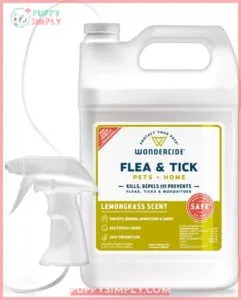
Wondercide’s Lemongrass Flea Tick Home Pet Spray is a plant-powered solution that kills, repels, and prevents fleas, ticks, and mosquitoes. It’s formulated with natural essential oils, making it safe for dogs and cats of all ages when used as directed. The spray is easy to use and can be applied to pets and their living spaces to eliminate pests and provide lasting protection.
To use the spray, follow these steps:
- Read the label carefully before use and apply as directed.
- Test a small area on your pet’s skin 1 hour before full application to check for sensitivity.
- Spray the body, legs, tail, belly, and armpits of your pet.
- Rub the spray into your pet’s coat in the opposite direction of growth.
- For cats, use the 4oz spray and apply the spray into your hands to massage on to your cat.
The spray is safe for daily use and can be used as often as needed for continuous protection. It’s also safe for use in your home, eliminating pests from carpets, furniture, and bedding.
Remember to always read the label carefully and follow the instructions for best results.
Best For: Pet owners seeking a natural and safe pest control solution for their pets and homes.
- Kills and repels fleas, ticks, and mosquitoes
- Formulated with natural essential oils
- Safe for pets and humans
- May not be effective for all pets
- Strong lemongrass scent may be overpowering for some
- Does not contain synthetic pesticides
5. Adams Plus Indoor Flea Fogger
When fleas play hide and seek in your home, Adams Plus Indoor Flea Fogger is the game-changer you need. This fogger doesn’t just shoo away the pesky critters; it delivers a knockout punch to fleas, ticks, and a whole gang of insects for up to seven months.
Imagine declaring war on fleas and their cronies with a single press of a button. It’s like sending in the special forces to reclaim your territory, ensuring your furry friends and family stay bite-free.
Just set it, forget it, and enjoy the peace of mind that comes with a pest-free home.
Best For: Those seeking effective and long-lasting flea control with minimal effort.
- Long-term flea control for up to seven months
- Kills a wide range of insects, including fleas, ticks, roaches, and spiders
- Non-staining formula with no lingering odor or mess
- May not be suitable for homes with birds or other sensitive pets
- Requires treatment of animals at the same time
- Can be more expensive than other flea control options
6. Harris Nite Light Flea Insect Trap
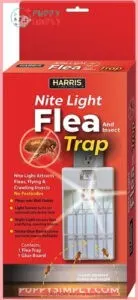
The Harris Nite Light Flea Insect Trap is a simple and effective solution for those looking to control flea infestations in their homes. This plug-in trap uses a night light that automatically turns on when the room is dark, attracting fleas and other insects with its warmth and light. When the insects reach the trap, they’re securely trapped by the glue board. The glue board can be replaced with a new refill as needed, making it a long-lasting solution.
Key Features of the Harris Nite Light Flea Insect Trap:
- Attracts and catches fleas and other flying and crawling insects that are attracted to light.
- Uses a glue board to trap insects.
- Has a light sensor that turns the bulb on automatically when the room is dark enough and back off when the room lightens, so you don’t have to remember to turn it on or off.
- Can be used to attract and catch fleas and other flying and crawling insects.
Using the Harris Nite Light Flea Insect Trap:
- Plug the trap into a wall outlet and let it do its job.
- When the glue board is full, replace it with a clean refill.
- For best results, use in conjunction with other flea control methods, such as flea shampoos, sprays, or drops.
The Harris Nite Light Flea Insect Trap is a pesticide-free and easy-to-use solution for those looking to control flea infestations in their homes. Its automatic night light and replaceable glue board make it a convenient and effective tool for keeping your home free of fleas and other insects.
Best For: Those looking for a pesticide-free and easy-to-use solution to control flea infestations in their homes.
- Automatically turns on when dark, attracting fleas with warmth
- Fleas get stuck on a replaceable glue board
- Can be used with other flea treatments
- Night light fixture may die after only two weeks
- Glue strip may not stay in the night light part
- May not be very effective at attracting fleas
7. Natural Care Flea Tick Carpet Powder
Natural Care Flea Tick Carpet Powder is a pet-safe solution for those who prefer a powder form of flea control. This product utilizes natural plant extracts to kill fleas, flea eggs, ticks, and ants on contact, making it an eco-friendly alternative to harsh chemical treatments.
The powder won’t stain carpets, rugs, upholstery, or other textiles, and it’s safe for use around dogs and cats 12 weeks and older, as well as the rest of the family.
Each container treats up to 800 square feet, ensuring thorough coverage of your home.
Best For: Those seeking a pet-safe, eco-friendly powder solution for flea and tick control.
- Kills fleas, flea eggs, ticks, and ants on contact using natural plant extracts
- Powder formula won’t stain carpets, rugs, or upholstery
- Safe for use around pets and family
- Some people find the smell strong
- Can clog vacuum cleaners
- May not be suitable for people with sensitive lungs
8. Vet’s Best Flea Tick Yard Kennel Spray
Vet’s Best Flea Tick Yard & Kennel Spray is a natural solution to combat fleas, ticks, and mosquitoes in your outdoor space. It uses a blend of peppermint oil and eugenol to kill fleas, flea eggs, flea larvae, and ticks on contact, making it an effective choice for pet owners who prefer natural products.
The spray is safe for use around children, pets, and even livestock, providing peace of mind for responsible pet owners. It can be applied to turf, lawns, kennels, patios, and other outdoor surfaces, and it isn’t harmful to trees, shrubs, bees, or flowers.
The product is designed to kill fleas and ticks by contact during initial application, but it doesn’t have a lasting residual effect, so it should be used in support of an ongoing pest control and maintenance program.
Best For: Pet owners looking for a natural solution to outdoor pests.
- Kills fleas, ticks, and mosquitoes on contact
- 100% certified natural ingredients
- Safe for use around children, pets, and livestock
- Does not have a lasting residual effect
- May need to be used in conjunction with other pest control methods
- Not waterproof
9. Advantage Multi Topical Solution for Dogs
Advantage Multi for Dogs is a topical solution that offers thorough flea and heartworm protection for your canine companion. It contains two active ingredients, imidacloprid and moxidectin, which work together to eradicate multiple parasites, including fleas, heartworms, and intestinal worms.
The solution is easy to apply and requires only one application per month. It’s suitable for dogs of various sizes, with dosages based on weight.
Advantage Multi is also effective against sarcoptic mange and can be used to treat heartworm microfilaria. However, it should be administered by a licensed veterinarian and isn’t suitable for cats.
Best For: Dogs of various sizes seeking comprehensive flea and heartworm protection
- Broad-spectrum parasitic control
- Convenient monthly application
- Easy to use
- Strong scent
- May not be suitable for dogs with meat flavor allergies
- Requires a prescription from a veterinarian
10. Frontline Plus Flea Tick Spot Treatment Medium Dogs
Frontline Plus for Medium Dogs packs a punch against pesky parasites. This topical treatment is your furry friend’s armor, shielding them from adult fleas, flea eggs, larvae, and those dreaded ticks.
With a dynamic duo of Fipronil and (S)-methoprene, it disrupts the flea life cycle and keeps your pooch protected for a full 30 days.
Waterproof and ready for action, it’s a breeze to apply. Just a quick spot treatment and your dog is set to frolic freely, without the itch!
Best For: Medium dogs and puppies 8 weeks and older weighing 23-44 lbs.
- Long-lasting protection for 30 days
- Waterproof and fast-acting
- Disrupts the flea life cycle
- May cause allergic reactions in some dogs
- Not effective against all ticks
- Should not be used on pregnant or nursing dogs
Flea and Tick Lifecycle and Behavior
To successfully address and prevent flea and tick infestations, it’s essential to comprehend their life cycles and behaviors. Understanding where ticks flourish and when they’re most active can assist you in taking proactive steps to safeguard your dog.
Understanding Flea Development Stages
The flea life cycle consists of four stages: egg, larva, pupa, and adult. The egg stage is the beginning of the flea’s life, and it hatches into a larva within a few days. Flea larvae are white, almost see-through, and legless, and they develop by eating flea dirt**, which is dried blood and looks like black specks. Larvae make up about 35% of the flea population in a household.
After the larvae develop, they spin cocoons, which are the pupae stage. Flea pupae can survive for months or even years if conditions aren’t right for emergence. Once conditions are suitable, the adult flea will emerge from the cocoon. Adult fleas are small, dark, and flat-bodied, and they need to feed on a host within a few hours of emerging from the cocoon.
Female fleas lay eggs after feeding, and these eggs will hatch into larvae if conditions are favorable. Understanding the flea life cycle is essential for effective flea control, as it helps you target the right stages of the flea’s development to break the cycle and prevent infestations.
Tick Habitats and Seasonal Activity
Ticks can pose a significant threat to your dog’s health, as they can carry and spread various diseases, including Lyme disease, Rocky Mountain spotted fever, anaplasmosis, ehrlichiosis, and babesiosis. To safeguard your dog from tick-borne diseases, it’s critical to grasp their habits and seasonal activity. Here are some key points to keep in mind:
- Ticks are ectoparasites that feed on the blood of their hosts, including dogs. They can transmit diseases through their bite.
- Tick-borne diseases are primarily spread by ticks, but ticks themselves aren’t the cause of the diseases. Instead, ticks become infected with bacteria and protozoal organisms during their life cycle and then transmit these diseases to dogs when they bite.
- Ticks are most active during specific seasons, with their activity influenced by factors such as temperature, humidity, and photoperiod.
- Ticks can survive in a variety of habitats, including wooded areas, grasslands, and even your own backyard.
- Ticks can be active year-round in some regions, especially with the effects of climate change.
To safeguard your dog from tick-borne diseases, it’s essential to use appropriate flea and tick prevention products, such as flea and tick pills, chewables, topical treatments, collars, shampoos, sprays, and wipes. Regularly inspect your dog for ticks, especially during tick season, and remove them promptly if found. Additionally, maintain a clean and tick-free environment, particularly in your home and yard.
Signs Your Dog Has Fleas or Ticks
Does your dog seem restless and perpetually scratching? That could be an indication of a flea infestation. Meanwhile, examining for diminutive ticks adhered to your pup’s skin is imperative to discern potential tick-borne diseases.
Identifying Flea Infestation Symptoms
Fleas are tiny, wingless insects that can cause a lot of discomfort and even health issues for your furry friend.
To identify a flea infestation, look for visible fleas on your dog’s body, which are flat-bodied and dark brown or black, less than an eighth of an inch big. Flea dirt, or flea feces, resembles dirt but turns reddish-brown when moistened.
Common flea symptoms include restlessness, excessive chewing, scratching, and licking.
Flea treatments and prevention methods include pills, chewables, topical treatments, collars, shampoos, sprays, and even flea combs.
Regularly checking your dog for fleas and treating them promptly is key to maintaining their health and happiness.
Recognizing Tick Bites and Their Effects
Tick bites can be hazardous for your dog, as they can transmit diseases such as Lyme disease, Rocky Mountain spotted fever, anaplasmosis, ehrlichiosis, and babesiosis. It’s vital to be informed about the signs and effects of tick bites to guarantee timely treatment and prevention measures. Here are some important points to bear in mind:
- Tick-borne diseases: Ticks can carry and spread various diseases, some of which can lead to severe health problems in dogs.
- Transmission methods: Ticks transmit diseases when they latch on and feed on a host’s blood.
- Prevention strategies: Regularly inspect your dog for ticks, particularly during tick season, and use suitable flea and tick repellents.
- Bite identification: Look for indications of tick bites, such as redness, swelling, or a rash at the bite site.
- Treatment options: If you discover a tick on your dog, remove it promptly and consult your veterinarian for appropriate treatment.
Choosing the Right Flea Treatment for Your Dog
When selecting the appropriate flea treatment for your canine companion, it’s imperative to evaluate factors such as their age, weight, health status, and the extent of the infestation. Contrast topical treatments applied directly to the skin with oral medications – each possesses distinct merits and limitations regarding efficacy, ease of administration, and duration of protection.
Factors to Consider for Effective Flea Control
When choosing a flea treatment, consider your dog’s age, weight, and any allergies they may have.
Capstar for dogs is great for quick relief.
However, remember that ease of use and treatment costs are important factors to consider.
Don’t forget, fleas can develop resistance, so mix it up with natural alternatives.
If you have multiple furry pets, treat all of them to keep those pesky fleas at bay.
Comparing Topical Vs. Oral Treatments
Regarding the selection of an appropriate flea treatment for your canine companion, the efficacy comparison, ease of administration, extended effectiveness, and cost disparities between topical and oral treatments are crucial factors to take into account. Below is a comparison of these two treatment categories:
Topical Treatments
- Effectiveness: Topical treatments can be highly effective in eradicating flea infestations and deterring new ones.
- Ease of Administration: They’re facile to apply, often requiring only a single application per lunar cycle.
- Long-term Efficacy: Topical treatments can provide enduring protection against fleas.
- Cost Differences: They’re generally less costly than oral treatments.
Oral Treatments
- Effectiveness: Oral treatments can be highly effective in exterminating fleas and preventing infestations.
- Ease of Administration: They’re facile to administer, often presented in the form of palatable tablets or liquids.
- Long-term Efficacy: They can provide enduring protection against fleas.
- Cost Differences: They’re generally more expensive than topical treatments.
Pet Preference
- Topical treatments may be favored by pets that have an aversion to the taste or texture of oral medications.
- Oral treatments may be favored by pet owners who find topical treatments untidy or challenging to apply.
When deciding between topical and oral treatments, take into account your pet’s age, weight, health status, and medication history, as well as your own preferences and the specific needs of your pet. Consult with your veterinarian for personalized recommendations and to ascertain that the selected flea treatment is safe and effective for your pet.
Preventing Flea and Tick Infestations in Your Home
To prevent flea and tick infestations in your home, you’ll need to be diligent with regular cleaning and maintenance. Vacuum carpets, rugs, and upholstered furniture frequently, and wash pet bedding and your family’s bedding in hot, soapy water on a weekly basis; these simple steps can help eliminate flea eggs and larvae before they mature into biting adults.
Regular Cleaning and Maintenance Tips
To prevent flea and tick infestations in your home, vacuuming regularly is essential.
However, it won’t necessarily kill fleas, ticks, or their eggs and larvae.
Carpet cleaning is also important, as fleas and ticks can lurk in your yard and catch a ride on your dog into your home.
Pet bedding hygiene is critical, so wash your dog’s bed often.
Consider using flea combs, flea control products like shampoo or spray, or flea collars.
Frequently Asked Questions (FAQs)
What is the best flea treatment for dogs?
You’re wondering what’s the best way to get rid of those pesky fleas, aren’t you? Well, let me tell you a little secret – the key is being proactive. By using a first-rate preventative treatment, you’ll nip that flea problem in the bud before it even starts.
How often should I apply flea and tick treatments on my dog?
You’ll want to apply flea and tick treatments monthly for complete protection. Some products last longer, but checking the label and following instructions is key. Consistency is paramount to keep those pesky pests away from your furry friend.
Can I use the same flea treatment for both dogs and cats?
No, you shouldn’t use the same flea treatment for dogs and cats. Their biological differences mean what works for one pet could be ineffective or potentially harmful for the other. Always check a product is approved for both species before applying it to your furry friends.
How long does it take for flea and tick treatments to start working?
It typically takes 12-24 hours for flea and tick meds to kick in. But you’ll see results within a few days as those nasty pests get eliminated from your furry friend’s coat. Just be patient – relief is on the way!
What should I do if my dog has an adverse reaction to a flea treatment?
If your pup has a reaction, stop the treatment right away. Contact your vet ASAP – they’ll assess the situation and advise next steps to keep your furry friend safe and itch-free.
Conclusion
Ultimately, finding the most effective flea treatment for dogs necessitates considering your pet’s requirements and living environment. Don’t let the prospect of time-consuming research discourage you; our thorough guide simplifies the process. Effectively managing fleas and ticks ensures your furry companion’s well-being while preventing infestations that disrupt your home’s tranquility.



